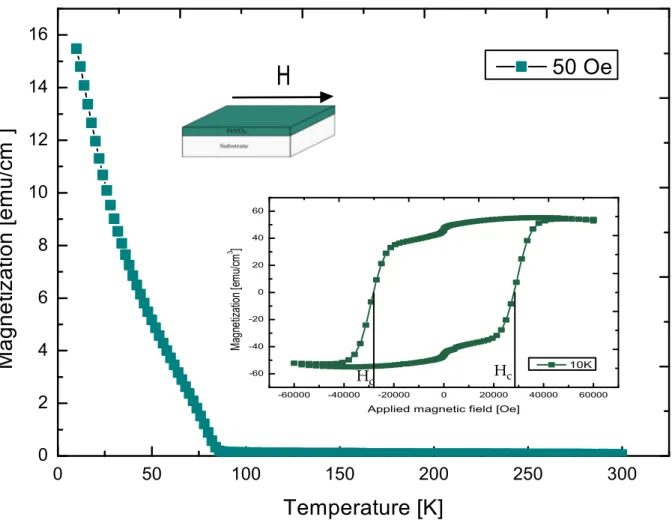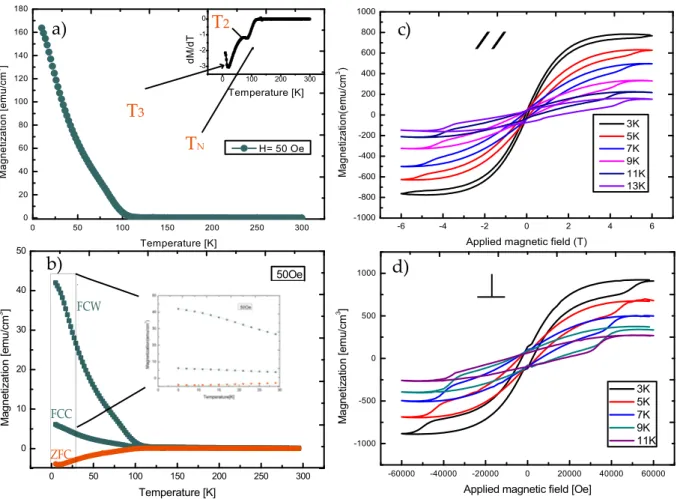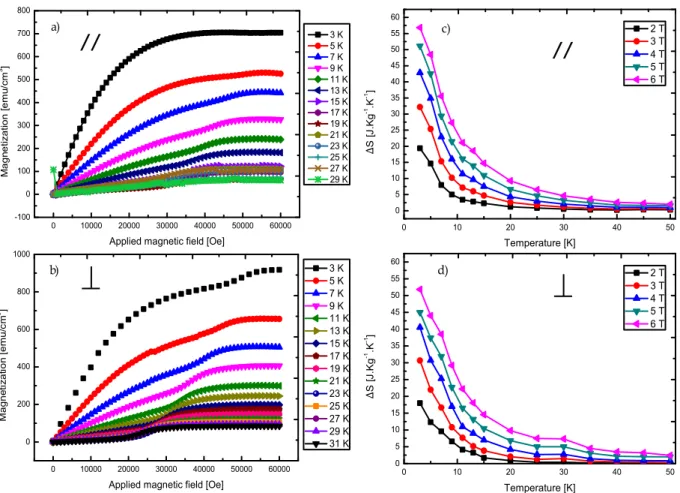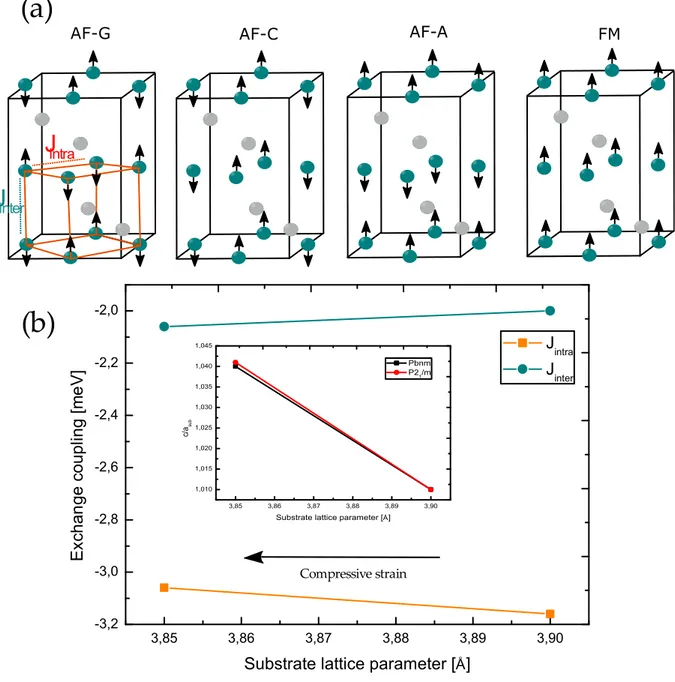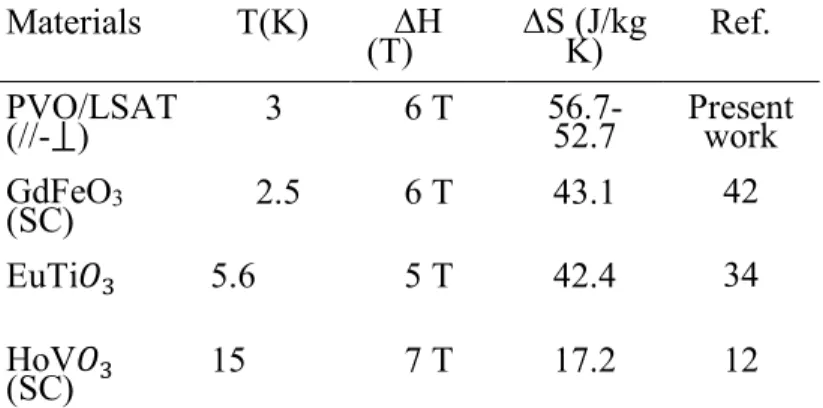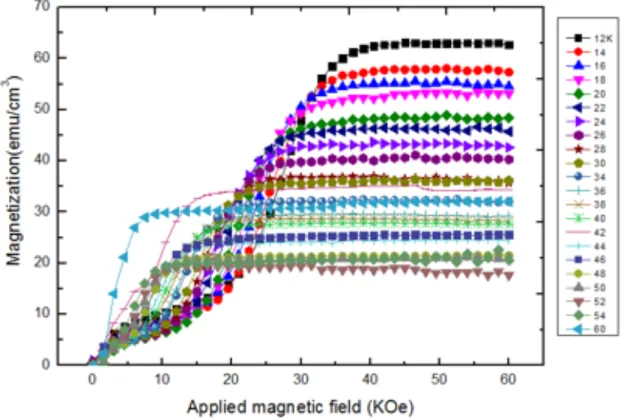HAL Id: hal-03016830
https://hal.archives-ouvertes.fr/hal-03016830
Submitted on 20 Nov 2020HAL is a multi-disciplinary open access archive for the deposit and dissemination of sci-entific research documents, whether they are pub-lished or not. The documents may come from teaching and research institutions in France or abroad, or from public or private research centers.
L’archive ouverte pluridisciplinaire HAL, est destinée au dépôt et à la diffusion de documents scientifiques de niveau recherche, publiés ou non, émanant des établissements d’enseignement et de recherche français ou étrangers, des laboratoires publics ou privés.
Hamza Bouhani, Asmaa Endichi, Deepac Kumar, O. Copie, Halima Zaari,
Adrian David, Arnaud Fouchet, Wilfrid Prellier, Omar Mounkachi, Mohamed
Balli, et al.
To cite this version:
Hamza Bouhani, Asmaa Endichi, Deepac Kumar, O. Copie, Halima Zaari, et al.. Engineering the magnetocaloric properties of PrVO 3 epitaxial oxide thin films by strain effects. Applied Physics Letters, American Institute of Physics, 2020, 117 (7), pp.072402. �10.1063/5.0021031�. �hal-03016830�
1
Engineering the magnetocaloric properties of epitaxial oxide thin films by strain effects Hamza Bouhani, Asmaa Endichi, Deepac Kumar, Olivier Copie, Halima Zaari, Wilfrid Prellier, Adrian David, Arnaud Fouchet, Omar Mounkachi, Mohamed Balli*, Abdelilah Benyoussef, Abdallah El Kenz and Stéphane Mangin
Dr. H. Bouhani, Dr. A. Endichi Dr. O. Copie, Prof. S. Mangin Institut Jean Lamour
UMR 7198 CNRS-Université de Lorraine F-54000, France
Dr. H. Bouhani, Dr. A. Endichi, Dr. H. Zaari, Pr. O. Mounkachi, Prof. A. Benyoussef, Prof A. El. Kenz.
Laboratory of Condensed Matter and Interdisciplinary Sciences (LaMCScI) Faculty of Science, Mohammed V University, 1014 Rabat, Morocco
Dr. D. Kumar Dr. A. David, Dr A. Fouchet, Dr. W. Prellier Normandie Univ.
ENSICAEN UNICAEN CNRS, CRISMAT
6 Boulevard Maréchal Juin, F-14050 Caen, Cedex 4, France Pr. Dr. M. Balli*
LERMA, ESIE
International University of Rabat
Parc Technopolis, Rocade de Rabat-Salé, 11100, Morocco
*mohamed.balli@uir.ac.ma
Keywords: strain engineering, magnetic refrigeration, perovskites, strongly correlated oxides, thin films
In this paper, we demonstrate how strain effects can be used to markedly tailor the
magnetic and magnetocaloric properties of PrVO3 thin films. The selection of appropriate
thickness and substrate enables us to dramatically decrease the coercive magnetic field
from 2.4 T previously observed in sintered PVO3 bulk to 0.05 T for compressive thin films
making from the PrVO3 compound a nearly soft magnet. This is associated with a marked
enhancement of the magnetic moment and the magnetocaloric effect that reach unusual
maximum values of roughly 4.86 µB and 56.8 J/kg K in the magnetic field change of 6 T
2
calculations based on the Density Functional Theory (DFT) confirm the ground state and
the enhancement of magnetic interactions via compressive strains in PrVO3 thin films.
The interplay between several degrees of freedom in complex functional materials gained a lot of interest due to its potential to enhance the caloric effects in new alternative
cooling technologies such as magnetic cooling [1-6]. The latter which is based on the
magnetocaloric effect (MCE) is an emergent, innovating and potentially low carbon technology
[7-8]. The MCE which is an intrinsic property of certain magnetic materials results in a change
of their thermal state when subjected to an external magnetic field. Currently, Gadolinium Gd is the magnetic material used in the vast majority of magnetic cooling prototypes, mainly due to its magnetic phase transition taking place at 294 K leading to excellent magnetocaloric
properties close to room temperature [9]. However, this metal presents multiple disadvantages
such as its easy oxidation as well as the limitation of its working temperature range close to the room temperature. In addition, gadolinium cannot be used in large scale applications because of its high cost. These issues have motivated the scientists to search for cheaper, safe and performant magnetocaloric materials under moderate magnetic fields including intermetallic
and oxides [8-9]. The magnetocaloric effect in manganite-based perovskites exhibiting
multiferroic behaviors have become an interesting topic because of the potential application of these oxides in some specific applications such as the liquefaction of hydrogen and space industry. This sort of compounds fulfills the necessary conditions for practical applications as they unveil a strong chemical stability, high electrical resistivity, low hysteresis and mechanical
stability [8, 9]. In contrast, the magnetocaloric potential of the 𝑅𝑉𝑂
$ vanadates (R = rare earth)
has not yet been explored except for the bulk 𝐻𝑜𝑉𝑂$ [12]. However, perovskite-type vanadium
oxides 𝑅𝑉𝑂$ display a great variety of phase transitions associated with a series of charge, spin
and orbital ordering phenomena making them interesting candidates from a magnetocaloric point of view.
3
Today's research activities on magnetocaloric thin films attract a wide interest due to their
potential integration in miniaturized electronic devices [13-14]. This particularly motivated us to
investigate the MCE in 𝑅𝑉𝑂$ thin films since their behavior strongly depends on the
cooperative nature of the Jahn-Teller distortion making them sensitive to strain effects including the induced biaxial strain due to the lattice mismatch between the substrate and the film. Such
structural effects tend to play an important role in tuning the film properties [15-16]. In this work,
we mainly focus on exploring and tuning the magnetic and magnetocaloric properties of high
quality epitaxial 𝑃𝑟𝑉𝑂$ (PVO) thin films by applying a compressive strain via a proper choice
of substrate.
𝑃𝑟𝑉𝑂$ thin films were grown by pulsed-laser deposition on two different cubic substrates,
namely, (001)-oriented (La,Sr)(Al,Ta) 𝑂$ (LSAT) and (001)-oriented 𝑆𝑟𝑇𝑖𝑂$ (see
experimental and methods).To investigate the strain effect on the magnetic properties of 𝑃𝑟𝑉𝑂$
thin films, the magnetization dependence on temperature was measured for PVO/𝑆𝑟𝑇𝑖𝑂$ under
an applied magnetic field of 50 Oe as shown in Figure 1. Hysteretic loop is also performed at 10 K in magnetic fields changing between –6 and 6 T (see the inset of Figure 1). To ensure a
perfect demagnetization, our sample was heated above 𝑇- and cooled down to the desired
temperature before each run. Magnetic measurements indicate hard-ferromagnetic behavior below 80 K similar to that reported previously for bulk PVO [17-19]. In fact, the S-shape of
magnetization depicts a metamagnetic transition which is defined as the transition between antiferromagnetic (AF) and ferromagnetic (F) configurations of spins under the effect of
magnetic fields or temperature change [20]. The intrinsic coercivity is ∼ 2.8 T while the
remanence magnetization is ∼ 48 emu/𝑐𝑚$. The magnetization saturation is found to be ∼ 54
emu/cm3 being equivalent to 0.291 µ
4
The presence of soft component can be seen at a magnetic field of ∼ 0.2 T indicated by the
shape of M vs H loop caused by the magnetic field induced transition which is absent at higher temperatures as earlier observed in ref. [21] The high coercivity may arise from the pinning mechanism due to the microstructure as well as the film unit cell orientation compared to the in-plane and out-of plane magnetic field directions. On the other hand, we observed a reduction
of 𝑇- compared to bulk PVO ( 𝑇- ≈ 140 K) which could be explained by the oxygen
vacancy-induced film lattice distortion [20]. XRD reveals that the pseudo cubic volume of PVO unit cell
when deposited on 𝑆𝑟𝑇𝑖𝑂$ (≃ 60.91 Å$ ) is larger than its equivalent of the bulk (≃ 58.86 Å$ )
[22]. As a result, the volume expansion decreases the transfer integral which tends to reduce the
neighbor exchange interactions as the magnetic interactions in this system are governed by super exchange mechanisms. It is worthy to mention that no significant magnetic anisotropy is observed when comparing the performed magnetic measurement under magnetic fields applied in and out of the sample plane.
Figures 2c-d display some selected isothermal magnetization curves for two different orientations measured up to 6 T of a PVO film deposited on a (001)-oriented LSAT substrate.
As shown, the magnetization saturation is markedly enhanced when compared to PVO/𝑆𝑟𝑇𝑖𝑂$,
reaching about ≃ 900 emu/𝑐𝑚$ and ≃ 785 emu/𝑐𝑚$ at 3 K for 𝐻⟘ (Figure. 2d) and H//
(Figure. 2c), respectively. At 10 K, the corresponding magnetization saturations are about ≃
402 emu/𝑐𝑚$ and ≃ 305 emu/𝑐𝑚$, respectively. These values are much larger than those of
𝑃𝑉𝑂/𝑆𝑟𝑇𝑖𝑂$ as can be clearly seen from the inset of Figure 1. In addition, the coercive field
is largely reduced to attain about 0.3 T and 1.1 T for hysteretic loops performed in plane and out of plane (Figure 2), respectively. More surprisingly, the coercive field decreases dramatically at 3 K reaching only 0.05 T for magnetic fields applied within the films plane as shown in Figure 2.d. This markedly contrasts with the conventional magnets in which usually the thermal excitations lead to the reduction of coercivity. This contrast could be attributed to
5
FM and AFM couplings or/and the spin and orbital transitions usually leading to stair-like
hysteresis observed in bulk 𝑃𝑟𝑉𝑂$[18]. The enhancement of coercivity when heating may also
be attributed to the stress induced magnetic anisotropy due to the relaxation of the surface stress
reported for various magnetic thin films [23].The temperature dependence of magnetization at
an in-plane applied magnetic field of 50 Oe is displayed in Figure 2a. As can be clearly observed, we can see a sharp decrease of magnetization at low temperature and a magnetic transition from
paramagnetic (PM) to an antiferromagnetic (AFM) phase transition occurs at 𝑇- = 125 K. Such
a transition is attributed to the beginning of a G-type spin ordering (G-SO) [17]. The
differentiation of the temperature-dependent magnetization is displayed in the inset of Figure
2a where two additional magnetic transitions take place at 𝑇: ≃ 20 K and 𝑇$ ≃ 80 K. These
transitions were absent in bulk 𝑃𝑉𝑂 [24] but they were recently reported in strained 𝑃𝑉𝑂 films
[21] and in doped 𝑃𝑟
;<=𝐶𝑎=𝑉𝑂$ compounds [25].Upon cooling down to 3 K, the plot of the first
derivative of the magnetization temperature dependence exhibits a minimum at very low temperature which could be explained by the polarization of the praseodymium magnetic moments. The newly established order is due to the fact that the antiferromagnetic vanadium sublattice produces an exchange field that results in a ferrimagnetic structure of Pr sublattice
under cooling as already observed in other vanadates [25]. This is supported by the presence of
a soft component at temperatures below 20 K (Figure 2c) and also by the fact that the
magnetization saturation reaches 4.86 and 5.54 µ2 at 3 K when a magnetic field is applied in
and out-of-plane, respectively. On the other hand, these findings inform us on the contribution
of both 𝑃𝑟$@and 𝑉$@ ions to the whole magnetization since the theoretical saturated moment
of free 𝑃𝑟$@ and 𝑉$@ ions are 3.22 and 2.12 µ
2 suggesting that all the praseodymium and
6
The ZFC, FCW and FCC curves were measured in 50 Oe field from 3 to 300 K for 𝑃𝑉𝑂/𝐿𝑆𝐴𝑇 as shown in Figure 2b. The bifurcation between FC and ZFC magnetizations indicates an intrinsic disorder and irreversibility being the characteristic of a complex system. This difference reflects the impact of the anisotropy on the shapes of ZFC and FC curves below the ordering temperature since the coercivity is related to the magnetic anisotropy. The latter plays an important role in determining the magnetization at a given field strength during both the ZFC and FC processes since it aligns the spins in a preferred direction. During the ZFC process, the spins are locked in random directions since no magnetic field is applied while cooling the thin films to the desired temperature. When a small magnetic field is applied at temperatures far
below 𝑇- and as the system is anisotropic [26], the magnetization decreases to reach negative
values indicating a possible competition between antiferromagnetic interactions, a
characteristic which is observed in orthovanadate 𝑅𝑉𝑂$ compounds [27]. A small negative
trapped field in the sample space as well as the coercivity could be responsible for the negative
magnetization [28]. During the FC process, the 𝑃𝑉𝑂 film is cooled under the application of a
magnetic field. Therefore, the spins will be aligned in a specific direction depending on the
strength of the applied magnetic field. Consequently, 𝑀DE continuously increases below 𝑇- as
the temperature decreases.
Magnetic isotherms collected under magnetic fields going from 0 up to 6 T at different temperatures are reported in Figures 3a-b for the 𝑃𝑉𝑂/𝐿𝑆𝐴𝑇 films. Except the isothermal magnetization at 3 K which shows a typical behavior of a ferromagnetic material, all the other isotherms follow a sharp increase when the magnetic field is below 30 kOe indicating a field induced first order metamagnetic transition from AFM to FM state as a result of the strong
competition between Pr 4f and V 3d spins [21,31]. Such a competition often leads to a giant MCE
in strongly correlated materials [29-31]. A similar behavior is found in the corresponding Arrot
plots (M² versus H/M) confirming the first order nature of the transition according to Banerjee
7
The large field-induced metamagnetic transition in 𝑃𝑉𝑂/𝐿𝑆𝐴𝑇 films and the soft component in M vs H below 30 K are a clear indication of a possible giant magnetic entropy change. In
order to explore the magnetocaloric effect in 𝑃𝑉𝑂 films, magnetic field-induced entropy
change −∆𝑆G was calculted from magnetic isotherms by using the well-known Maxwell
relation (MR) given as follow:
∆SI = J ( ∂ 𝑀 ∂ 𝑇 ) N O N d𝐻
We are aware that the utilization of Maxell relation to evaluate entropy changes in materials showing large hysteretic effects could lead to spurious values as already demonstrated by one
of the present paper authors [32]. However, the Maxwell relation can be also used to reasonably
evaluate the MCE in term of the entropy change even in first-order phase transition materials provided that the remaining magnetization from previous isotherms is suppressed via a thermal
loop [33]. On the other hand, it has been demonstrated recently that the magnetocaloric effect in
multiferroics could be evaluated perfectly via Maxwell relation [34]. In this way, it has been
particularly found that the deduced entropy change from magnetization measurements of
𝐸𝑢𝑇𝑖𝑂$ fits perfectly with that obtained from specific heat data [34].
In our case, magnetic isotherms of Figure 3a-b are used to calculate the entropy change exhibited by the 𝑃𝑉𝑂 films on 𝐿𝑆𝐴𝑇. However, since the entropy change is proportional to the
aera between two successive isotherms, Δ𝑆G was directly calculated without subtracting the
magnetic contribution arising from the substrate as already done in the case of 𝐿𝑎:𝑁𝑖𝑀𝑛𝑂U
thin films [35]. For 𝑃𝑉𝑂/𝑆𝑇𝑂, it was difficult to calculate the MCE because of the overlap
between M vs H curves (see Supplementary material) at low temperatures.
The temperature dependence of the magnetic entropy change unveils larger values at very low
temperature for 𝑃𝑉𝑂/𝐿𝑆𝐴𝑇 films. −∆SI reaches roughly a maximum value of 56.7
8
3a), being about 63% of its theoretical limit given by R*Ln(2J+1). In a similar field change applied out of plane(Figure 3b), − ∆SIis slightly lower and found to be about 52.7 J. 𝑘𝑔<;. 𝐾<;.
Also, the magnetic entropy change shows a large magnetocaloric effect under relatively low magnetic fields that can be easily reached via permanent magnets. In the magnetic field change
of 2 T applied within and out of thin films plane, − ∆SI reaches 19.5 and 16.3 J. 𝑘𝑔<;. 𝐾<;,
respectively. As shown in Figures 3b-c, a large magnetocaloric effect can be induced below the AFM transition temperature. This suggests that a major part of the contribution to the MCE comes from the praseodymium 4f spins.
A list of some relevant magnetocaloric materials working in the cryogenic temperature range
are reported in Table 1 for comparison. As shown, the exhibited ∆𝑆G by the strained 𝑃𝑉𝑂 film
is significantly larger than its equivalent reported for several rare-earth metal transition oxides making the PVO films potential candidates for low temperature magnetic refrigeration.
Theoretical calculations are important for a better understanding of the fundamental mechanisms behind the physical properties of materials. Here, ab initio calculations based on the density functional theory (DFT) were performed to investigate the magnetic and magnetocaloric features of both bulk and thin films of 𝑃𝑉𝑂. In order to check the ground state of bulk 𝑃𝑉𝑂, the total energies of four different magnetic ordering configurations are calculated using GGA+U approximation. The ferromagnetic (FM) and the three antiferromagnetic (AFM) structures are shown in Figure 4a and denoted by AF-G, AF-C and AF-A. Our results indicate a ground state magnetic structure where the vanadium spins form a C-type AFM structure being
consistent with previous studies [17-21]. For thin films calculations, two different orientations
have been taken into account. First, we preserve the bulk Pbnm symmetry for a growth along the [001] direction where the two lattice vectors of the orthorhombic unit cell lie within the substrate plane. A second growth along the orthorhombic [110] direction where the
9
that results in monoclinic unit cell was found to be clearly preferable by comparing the total energy difference between the two symmetries. It yields to G-type spin ordering for 𝑃𝑉𝑂 grown on both 𝐿𝑆𝐴𝑇 and 𝑆𝑇𝑂 substrates.
The enhancement of magnetic interactions under compressive strains is also seen when using
DFT calculations. The intraplane and interplane magnetic exchange interactions 𝐽\]^_` and
𝐽\]^a_ can be determined from the relation between the exchange parameters 𝐽\,c and the magnetic energies 𝑒\,c of four magnetic configurations, 𝑒\,c = 𝐽\,c. 𝑆\𝑆c based on the effective
Heisenberg model H= ∑\,c 𝐽\,c. 𝑆\𝑆c where 𝑆\ takes 1 restricted to nearest neighbor vanadium
sites (Figure 4b). As shown, the intraplane magnetic exchange interactions increase due to the compressive strain effect along the [110] direction. In fact, the film lattice parameters tend to match those of the substrate leading to an increase in the out-of-plane lattice parameter. This can be clearly seen when plotting the c/a sub ratio for two orientations as a function of lattice
parameter 𝑎fgh of the substrate (See inset of Figure 4b). It is worth noting that some of Pr-V
pairs are found to interact ferromagnetically confirming the competition between AFM and FM interactions.
To sum up, we have investigated the magnetic and magnetocaloric properties of 𝑃𝑉𝑂 films grown by pulsed laser deposition, in view of their potential application in cryogenic magnetic cooling. The obtained results reveal that the magnetic and magnetocaloric properties of 𝑃𝑉𝑂 compounds can be easily tailored by using the thin films approach. Particularly, the coercive
magnetic field was dramatically decreased making from the 𝑃𝑉𝑂 compound a nearly soft
magnet. Accordingly, a giant MCE is exhibited by 𝑃𝑉𝑂 thin films grown on 𝐿𝑆𝐴𝑇 substrates at low temperatures pointing out the great impact of strain effects and the competition between AFM and FM exchange interactions. This finding would open the way for the implementation of 𝑃𝑉𝑂 thin films in some specific applications such as on-chip magnetic micro-refrigeration
10
and sensor technology. On the other hand, DFT calculations have confirmed the ground state and the enhancement of magnetic interactions via compressive strains in 𝑃𝑉𝑂 thin films. Our result not only suggests that epitaxial 𝑃𝑉𝑂 thin films present a non-negligible potential for refrigeration at cryogenic temperatures but may also pave the way for new applications taking for example advantage of the possibility to tailor the magnetic coercivity in 𝑃𝑉𝑂 thin films. However, we are aware that the reported entropy change values in 𝑃𝑉𝑂 thin films are too large when compared to the best magnetocaloric materials working in a similar working temperature range. The necessary was done to reasonably evaluate the MCE in term of the entropy change by considering the impact of hysteretic phenomena. However, in order to accurately estimate ΔS, the measurements of specific heat in equilibrium conditions are highly required. This point will be certainly addressed in the future.
EXPERIMENTS AND METHODS
EXPERIMENTS: The epitaxial PVO films were grown by pulsed-laser deposition (PLD) on
two different cubic substrates, namely, (001)-oriented (La,Sr)(Al,Ta)𝑂$ (LSAT) and
(001)-oriented 𝑆𝑟𝑇𝑖𝑂$ (STO). Their in and out-of-plane lattice parameter are found to be 3.868 Å
and 3.95 Å with a thickness of 41.7 nm for the 𝐿𝑆𝐴𝑇 film while those of the 𝑆𝑟𝑇𝑖𝑂$ film are
3.905 Å and 3.92 Å with a thickness of 100 nm. The films deposition was carried out with a KrF excimer laser (λ = 248 nm) with a repetition rate of 2 Hz and a laser fluence of ∼ 2 J/𝑐𝑚² focusing on stoichiometric ceramic targets. The thin films were deposited at an optimum growth
temperature (𝑇jklmno) of 650 °C and under oxygen partial pressure (𝑃jklmno ) of 10<U bar.
In ZFC measurements our sample was cooled to the desired temperature without the application of a magnetic field, then data were collected while heating under magnetic field. For the FC process, the sample was cooled in the presence of an external magnetic field to the desired
11
temperature. We performed two modes, field cooled cooling (FCC) and field cooled warming (FCW) where data are collected during the cooling and heating processes, respectively. The in-plane and out-of-plane magnetizations were performed by using the Quantum Design SQUID-VSM. Each hysteresis loop was measured after a 150 K excursion above the Néel temperature and corrected by subtracting the diamagnetic contribution arising from the substrate.
THEORY: Based on the density functional theory (DFT), first principles calculations were
performed using Vienna Ab Initio simulation Package [37-39] with the PBE functional used to
reproduce the electronic exchange correlation while the projector augmented-wave (PAW) was employed to construct the pseudopotential of all involved species. We performed a U correction
of 3.5 eV [41] to deal with the strong on-site Coulomb interaction of 3 d electrons. The cut-off
energy set to 500 eV and a k-points shell of 6x6x6 according to the Monkhorst-Pack grid was used for orthorhombic structures which is found to yield a better convergence. For bulk calculations, all cell parameters and atomic positions are relaxed within Pbnm symmetry. In order to study the effect of epitaxial strain arising from the film/substrate lattice mismatch, bulk geometry has been subjected to an epitaxial constraint on its lattice parameters. Two different growth orientations are considered. The first growth is along the Pbnm [001] direction where the two lattice vectors of the orthorhombic unit cell lie within the substrate plane with a = b =
√2𝑎fgh (𝑎fgh = substrate lattice) to preserve the Pbnm symmetry of the bulk 𝑃𝑉𝑂. The second
growth is considered along the orthorhombic [110] direction where the compressive constraint
lowers the symmetry to 𝑃2;/𝑚 resulting in a monoclinic cell unit with γ ≠ 9 0 °. The in-plane
lattice parameters are set equal to the lattice constant of the substrate, while the out-of-plane parameter is optimized for each value of the substrate parameter and all the structures are
12
relaxed until the forces on atoms were less than 3 meV/Å . Four magnetic states are considered in the simulation (Ferromagnetic, G-type, C-type, and A-type antiferromagnetic).
Acknowledgements
This work was supported by PHC Toubkal 17/49 project. M. Balli highly appreciates the financial support from the International University of Rabat.
References
[1] M. S. Song, K. K. Cho, B. Y. Kang, S. B. Lee & B. K. Cho. Sci Rep. 2020, 10, 803.
[2] S. Murakami, N. Nagaosa, Phys. Rev. Lett. 2003, 90, 197201.
[3] Y. Tokura, Rep. Prog. Phys. 2006, 69, 797.
[4] Taguchi, Y., Sakai, H., Choudhury, D., Adv. Mater. 2017, 29, 1606144.
[5] D. Choudhury, T. Suzuki, D. Okuyama, D. Morikawa, K. Kato, M. Takata, K.
Kobayashi, R. Kumai, H. Nakao, Y. Murakami, M. Bremholm, B. B. Iversen, T. Arima, Y. Tokura, Y. Taguchi, Phys. Rev. B 2014, 89, 104427.
[6] N. H. Dung, Z. Q. Ou, L. Caron, L. Zhang, D. T. Cam Thanh, G. A. de Wijs, R. A. de Groot, K. H. J. Buschow, E. Brück, Adv. Energy Mater. 2011, 1, 1215.
[7] M. Balli, S. Jandl, P. Fournier, and A. Kedous-Lebouc, App. Phy. Rev. 2017, 4, 021305.
[8] O. Tegus, E. Brück, K. H. J. Buschow, and F. R. de Boer, Nature. 2002, 415, 150.
[9] G. V. Brown J. App. Phy. 1976, 47, 3673.
[10] M. Balli, S. Jandl, P. Fournier, and M. M. Gospodinov, Appl. Phys. Lett. 2014, 104, 232402.
[11] M. H. Phan and S. C. Yu, J. Magn. Magn. Mater. 2007, 308, 325.
[12] M. Balli, B. Roberge, S. Jandl, P. Fournier, T. T. M. Palstra, and A. A. Nugroho, J. Appl. Phys. 2015, 118, 073903.
[13] X. Moya, L. E. Hueso, F. Maccherozzi, A. I. Tovstolytkin, D. I. Podyalovskii, C. Ducati, L. C. Phillips, M. Ghidini, O. Hovorka, A. Berger, M. E. Vickers, E. Defay, S. S. Dhesi, and N. D. Mathur, Nat. Mater. 2013, 12, 52.
[14] Y. Liu, C. Phillips, R. Mattana, M. Bibes, A. Barthélémy and B. Dkhil. Nat. Comm. 2016, 7, 11614 .
[15] R. A. Rao, D. Lavric, T. K. Nath, C. B. Eom, L. Wu, and F. Tsui, Appl. Phys. Lett. 1998, 73, 3294.
[16] M.Chen, S. Bao, Y. Zhang, Y. Wang, Y. Liang, J. Wu, T. Huang, L. Wu, P. Yu, J. Zhu, Y. Lin, J. Ma, C.W. Nan, A. J. Jacobson, and C. Chen. Appl. Phys. Lett. 2019, 115, 081903 [17] O. Copie, J. Varignon, H. Rotella, G. Steciuk, P. Boullay, A. Pautrat, A. David, B. Mercey, P. Ghosez, W. Prellier, Adv.Mater. 2017, 29, 1604112.
[18] L. D. Tung, Phy. Rev. B, 2005, 72, 054414.
[19] F. Wang, J. Zhang, P. Yuan, Q. Yan, P. Zhang, J. Phys.: Condens. Matter, 2000, 12, 3037.
[20] S. Chikazumi, Physics of Ferromagnetism, Oxford University Press Inc., New-York, 1991.
13
[21] D. Kumar, A. David, A. Fouchet, A. Pautrat, J. Varignon, C. U. Jung, U. Lüders, B. Domengès, O. Copie, P. Ghosez, and W. Prellier, Phys. Rev. B, 2019, 99, 224405.
[22] O. Copie, H. Rotella, P. Boullay, M. Morales, A. Pautrat, P.-E. Janolin, I. C. Infante, D. Pravathana, U. Lüders, and W. Prellier, J. Phys.: Condens. Matter, 2013 25, 492201.
[23] N. Anuniwat, M. Ding, S. J. Poon, S. A. Wolf, and J. Lu, J. Appl. Phys. 2013, 113, 43905.
[24] S. Miyasaka, Y. Okimoto, M. Iwama, Y. Tokura, Phys. Rev. B. 2003, 68, 100406. [25] M. Reehuis, C. Ulrich, P. M. Abdala, P. Pattison, G. Khaliullin, J. Fujioka, S. Miyasaka, Y. Tokura, B. Keimer, Phys. Rev. B. 2016, 94, 104436.
[26] P A Joy., P S Anil Kumar. and S K Date J. Phys. Condens. Matter 1998, 10, 11049. [27] L. D. Tung, M. R. Lees, G. Balakrishnan, and D. McK. Paul, Phys. Rev. B, 2007, 75, 104404.
[28] N. Kumar and A. Sundaresan, Solid State Commun. 2010, 150, 1162.
[29] A. Midya, P. Mandal, S. Das, S. Banerjee, L. S. S. Chandra, V. Ganesan, and S. R. Barman, Appl. Phys. Lett. 2010, 96, 142514.
[30] M. Shao, S. Cao, S. Yuan, J. Shang, B. Kang, B. Lu, and J. Zhang, Appl. Phys. Lett. 2012, 100, 222404.
[31] A. Midya, N. Khan, D. Bhoi, and P. Manda, Appl. Phys. Lett. 2013, 103, 092402. [32] M. Balli, D. Fruchart, D. Gignoux, and R. Zach, Appl. Phys. Lett. 2009, 95, 072509. [33] L. Caron, Z. Q. Oub, T. T. Nguyen, D. T. Cam Thanh, O. Tegus, E. Bruck, J. Magn. Magn. Mater. 2009, 321, 3559.
[34] A. Midya, P. Mandal, K. Rubi, R. Chen, J. S. Wang, R.Mahendiran, G. Lorusso, and M. Evangelisti, Phys.Rev.B 2016, 93,094422.
[35] D. Matte, M. de Lafontaine, A. Ouellet, M. Balli, and P. Fournier, Phys. Rev. App. 2018,
9, 054042.
[36] B. K. Banerjee, Phys. Lett. 1964, 12, 16.
[37] R. A. Rao, D. Lavric, T. K. Nath, C. B. Eom, L. Wu, and F. Tsui. Appl. Phys. Lett. 1998, 73, 3294.
[38] G. Kresse & J. Hafner, Ab initio molecular dynamics for liquid metals. Phys. Rev. B 1993, 47, 558.
[39] P.E. Blochl. Projector augmented-wave method. Phys. Rev. B. 1994, 50, 17953_17979. [40] G. Kresse & J. Furthmuller, Phys. Rev. B. 1996, 54, 11169.
[41] S. L. Dudarev, G. A. Botton, S. Y. Savrasov, C. J. Humphreys, A. P. Sutton, Phy. Revi. B. 1998, 57, 1505.
14
Figure 1. Magnetization dependence of temperature for PrV 𝑂$ film on SrTi 𝑂$ substrate
performed under an in-plane applied magnetic field of 50 Oe. Inset displays the magnetic hysteresis loops measured at 10 K after subtracting the diamagnetic contribution of the substrate and the holder.
H
0 50 100 150 200 250 300 0 2 4 6 8 10 12 14 16M
a
g
n
e
tiz
a
tio
n
[e
m
u
/c
m
3]
Temperature [K]
50 Oe
-60000 -40000 -20000 0 20000 40000 60000 -60 -40 -20 0 20 40 60 M ag ne tiz at io n [e m u/ cm 3 ]Applied magnetic field [Oe]
10K
Hc Hc
15
Figure 2. (a) Temperature dependence of magnetization of PrV𝑂$ on LSAT thin film under an
in-plane applied magnetic field of 50 Oe. Inset: differentiation of the temperature-dependent magnetization. (b) Temperature dependence of magnetization in zero field-cooling (ZFC), field cooled cooling (FCC) and field cooled warming (FCW) conditions. (c, d) Some selected magnetic isotherms in the temperature range 3-13 K for PVO/LSAT collected in-plane (c) and out-of-plane (d) applied magnetic field.
-60000 -40000 -20000 0 20000 40000 60000 -1000 -500 0 500 1000 M ag ne tiz at io n [e m u/ cm 3]
Applied magnetic field [Oe]
3K 5K 7K 9K 11K 0 50 100 150 200 250 300 0 20 40 60 80 100 120 140 160 180 M a g n e tiz a tio n [e m u /c m 3 ] Temperature [K] H= 50 Oe 0 100 200 300 -3 -2 -1 0 d M /d T Temperature [K] 0 50 100 150 200 250 300 0 10 20 30 40 50 M ag ne tiz at io n [e m u/ cm 3 ] Temperature [K] 50Oe d FCW FCC ZFC c) b) // TN T3 T2 a) d) -6 -4 -2 0 2 4 6 -1000 -800 -600 -400 -200 0 200 400 600 800 1000 M ag ne tiz at io n( em u/ cm 3 )
Applied magnetic field (T)
3K 5K 7K 9K 11K 13K
16
Figure 3. Magnetic and MCE properties of PrV𝑂$ on LSAT. a) Magnetic isotherms in the
temperature range of 3-31 K with a step of 2 K under an in-plane (a) and out-of-plane (b)
magnetic field. Each magnetic isotherm was measured after thermal excursion above 𝑇- to
ensure a perfect demagnetization of the sample and corrected for diamagnetic background
signal. (c, d) Temperature dependence of magnetic entropy change of PrV𝑂$/LSAT under
some selected magnetic fields applied within (c) and out-of-plane (d). . 0 10000 20000 30000 40000 50000 60000 0 200 400 600 800 1000 M a g n e ti za tio n [ e m u /c m 3]
Applied magnetic field [Oe]
3 K 5 K 7 K 9 K 11 K 13 K 15 K 17 K 19 K 21 K 23 K 25 K 27 K 29 K 31 K 0 10000 20000 30000 40000 50000 60000 -100 0 100 200 300 400 500 600 700 M a g n e tiz a tio n [ e m u /c m 3 ]
Applied magnetic field [Oe]
3 K 5 K 7 K 9 K 11 K 13 K 15 K 17 K 19 K 21 K 23 K 25 K 27 K 29 K // c) 0 10 20 30 40 50 0 5 10 15 20 25 30 35 40 45 50 55 60 ∆ S [J .K g -1 .K -1 ] Temperature [K] 2 T 3 T 4 T 5 T 6 T 0 10 20 30 40 50 0 5 10 15 20 25 30 35 40 45 50 55 60 ∆ S [J .K g -1 .K -1 ] Temperature [K] 2 T 3 T 4 T 5 T 6 T b) // a) d)
17
Figure 4. a) Distorted perovskite magnetic structure of PrV𝑂$ in which the pseudocubic cell
is shown by orange lines. Four magnetic structures are schematically shown: Ferromagnetic (FM), C-type antiferromagnetic, G-type antiferromagnetic and A-type ferromagnetic. The grey and green spheres represent Pr and V atoms, respectively. b) Exchange coupling versus the
lattice parameter related to STO and LSAT substrates. Inset shows the c/𝑎fgh ratio for two
orientations as a function of lattice parameter 𝑎fgh of the substrate.
3,85 3,86 3,87 3,88 3,89 3,90 -3,2 -3,0 -2,8 -2,6 -2,4 -2,2 -2,0 3,85 3,86 3,87 3,88 3,89 3,90 1,010 1,015 1,020 1,025 1,030 1,035 1,040 1,045 c/ asub
Substrate lattice parameter [Å] Pbnm P21/m E xc ha n ge c ou pl in g [m e V ]
Substrate lattice parameter [Å]
Jintra Jinter Compressive strain AF-A FM AF-C AF-G
J
intraJ
inter(a)
(b)
18
Table 1. Maximum magnetic entropy change ∆𝑆Gshown by PrV𝑂$ deposited on LSAT
substrate compared to some relevant cryomagnetocaloric compounds. SC means single crystal Materials T(K) ∆H (T) ∆S (J/kg K) Ref. PVO/LSAT (//-⟘) 3 6 T 56.7-52.7 Present work GdFeO3 (SC) 2.5 6 T 43.1 42 EuTi𝑂$ 5.6 5 T 42.4 34 HoV𝑂$ (SC) 15 7 T 17.2 12
19
Supporting Information
Engineering the magnetic and magnetocaloric properties of epitaxial oxide thin films by strain effects
Hamza Bouhani, Asmaa Endichi, Deepac Kumar, Olivier Copie, Halima Zaari, Wilfrid Prellier, Adrien David, Arnaud Fouchet, Omar Mounkachi, Mohamed Balli, Abdelilah Benyoussef, Abdallah El Kenz and Stéphane Mangin
Figure S1. Magnetic isotherms of PVO on STO with a magnetic field applied within the
